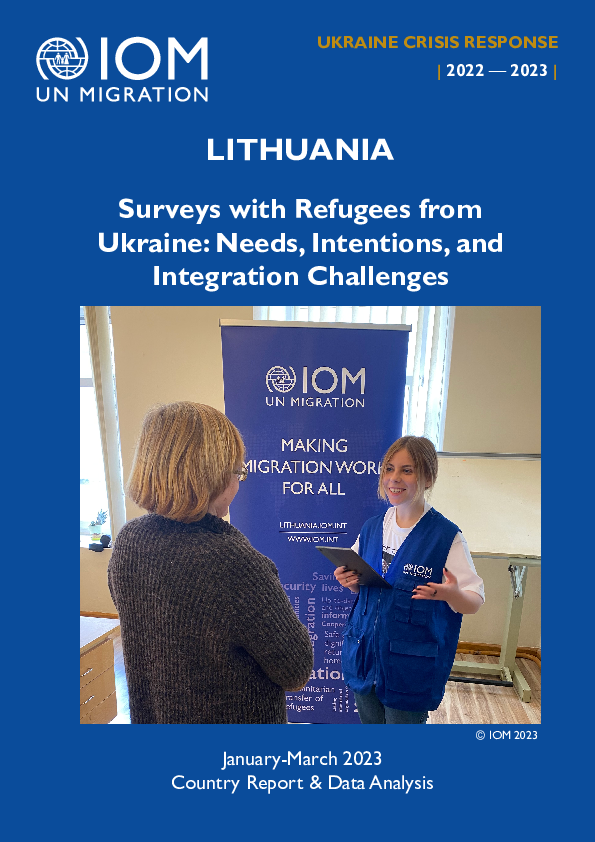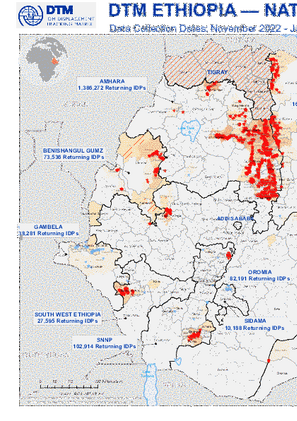-
Countries
-
Data and Analysis
-
Special Focus
-
Crisis Responses

Contact
DTM Yemen, iomyemendtm@iom.int
Language
English
Location
Yemen
Period Covered
Jun 04 2023
Jun 10 2023
Activity
- Rapid Emergency Registration
- Mobility Tracking
IOM Yemen DTM’s Rapid Displacement Tracking (RDT) tool collects data on estimated numbers of households forced to flee on a daily basis from their locations of origin or displacement, allowing for regular reporting of new displacements in terms of estimated numbers, geography, and needs. It also tracks returnees who returned to their location of origin.
From 1 January to 10 June 2023, IOM Yemen DTM tracked 3,339 households (HH) (20,034 Individuals) who experienced displacement at least once.
Between 4 and 10 June 2023, IOM Yemen DTM tracked 23 households (138 individuals) displaced at least once.
The majority of people moved into/within the following governorates and districts:
- Ta’iz (10 HHs) – Al Makha (8 HHs), Al Misrakh (2 HHs) districts. Most displacements in the governorate were internal.
- Al Hodeidah (7 HHs) – Hays (6 HHs), Al Khukhah (1 HH) districts. Most displacements in the governorate originated from Al Hodeidah and Ta’iz.
- Ma’rib (6 HHs) – Harib (3 HHs), Ma’rib City (2 HHs), Raghwan (1 HH) districts. Most displacements in the governorate originated from Abyan and Al Mahwit.
The majority of people moved from the following governorates and districts:
- Ta’iz (11 HHs) – Maqbanah (10 HHs), Al Makha (1 HH) districts.
- Al Hodeidah (4 HHs) – Jabal Ras (4 HHs) district.
- Abyan (3 HHs) – Lawdar (3 HHs) district.
Between 25 November 2022 and 9 January 2023, IOM’s DTM deployed Site Assessment (SA) Round 32 and Village Assessment Survey (VAS) Round 15. SA is conducted in locations hosting a reported 20 or more IDP households, and the VAS is conducted in locations hosting a reported 20 or more returning IDP households that returned after 1 January 2021. The National Returns Map visualizes locations of return, density of return caseload, primary reasons for initial displacement, estimated return figures, and access constraints.

Contact
DTM Pakistan, iomisbdtmremapteam@iom.int
Language
English
Location
Pakistan
Period Covered
May 21 2023
Jun 03 2023
Activity
- Flow Monitoring
Between 21 May and 03 June 2023, 4,866 undocumented Afghan nationals spontaneously returned to Afghanistan, including 2,074 through the Torkham border point and 2,792 through the Chaman border point. Border authorities facilitated the return of 273 individuals due to the lack of legal documentation to remain in Pakistan. Therefore, information about these individuals are not included in the count. Although IOM identified 33,904 undocumented Afghan returnees (between 1 January - 3 June 2023) at two border crossings, this may not reflect the total number of undocumented Afghan returnees. Moreover, for this study, only the head of household or representative of the family were interviewed. This means that the number of interviews conducted by the enumerators is lower than the number of returnees recorded by IOM. Between 21 May and 3 June 2023, IOM interviewed 226 respondents.
Contact
DTMDRC@iom.int
Location
Democratic Republic of the Congo
Activity
- Mobility Tracking
- Baseline Assessment
Period Covered
Feb 14 2023 -May 04 2023
During this ninth evaluation cycle conducted between February and May 2023, the DTM evaluations made it possible to count a total of 2,544,880 internally displaced persons (IDPs) in the province of Nord-Kivu, including: 2,156,803 IDPs in the host community over the last 36 months (compared to the 1,779,202 arrivals over the last 24 months), 242,462 people through the 230 spontaneous sites and collective centers, and 145,615 people in the 36 sites under the coordination of the CCCM mechanism identified as part of this exercise. This represents a 40 percent increase compared to the stock of 1,817,860 people on the move during the last assessment conducted for the month of September 2022.
Population Groups
Survey Methodology
Unit of Analysis Or Observation
Type of Survey or Assessment
Keywords
Geographical Scope
Administrative boundaries with available data
The current dataset covers the following administrative boundaries
Between 25 November 2022 and 9 January 2023, IOM’s DTM deployed Site Assessment (SA) Round 32 and Village Assessment Survey (VAS) Round 15. SA is conducted in locations hosting a reported 20 or more IDP households, and the VAS is conducted in locations hosting a reported 20 or more returning IDP households that returned after 1 January 2021. The National Displacement Map visualizes locations of displacement, density of displacement caseload, primary reasons for displacement, estimated displacement figures, and access constraints.

Contact
DTM Ethiopia, DTMEthiopia@iom.int
Language
English
Location
Ethiopia
Period Covered
Nov 25 2022
Feb 09 2023
Activity
- Mobility Tracking
- Site Assessment
- Village Assessment
In order to capture the displacement and return dynamics in Ethiopia, DTM Ethiopia's National Displacement Report combines findings from its Site Assessment (SA) in Section 1 and findings from the Village Assessment Survey (VAS) in Section 2. The Site Assessment tracks the number of internally displaced persons (IDPs), while the Village Assessment Survey tracks the number of IDPs who are returning or have returned to their communities.
According to data collected through the Site Assessment round 32 between November 2022 and January 2023, 3.14 million IDPs (579,672 households) were internally displaced across 2,472 accessible sites in Ethiopia. Tigray region was covered in this round but data was shared separately.
According to the data collected through the Village Assessment Survey round 15 between November 2022 and January 2023, there were an estimated 1.89 million returning IDPs (424,162 households) across 1,727 villages in Ethiopia. Tigray region was covered in this round but data was shared separately.

Contact
dushanbe@iom.int
Language
Russian
Location
Tajikistan
Period Covered
Dec 01 2022
Feb 28 2023
Activity
- Survey
- Baseline Assessment
С декабря 2022 г. по февраль 2023 г. Миссия МОМ в Таджикистане провела оценку 859 сёл в 12 районах2 , где были проведены 1875 интервью с ключевыми информантами (20% - женщин) для базовой оценки и 979 интервью (из них 12% составили женщины) с возвращающимися в страну трудовыми мигрантами.
Базовая оценка была нацелена на три группы населения: (1) международные трудовые мигранты, (2) возвращающиеся трудящиеся мигранты и (3) эмигранты. С 2020 по 2022 годы Миссия МОМ в Таджикистане выявило 123 194 возвращающихся трудовых мигрантов, 3 111 международных трудящихся мигрантов и 251 180 таджиков, которые на момент проведения базовой оценки находились за границей в качестве эмигрантов.
Районы Вахдат и Рудаки (РРП), город Куляб (Хатлонская область) и район Сино города Душанбе приняли наибольшее количество возвращающихся трудящихся мигрантов соответственно. В 2021 году наблюдалось увеличение на 21% по сравнению с 2020 годом, а в 2022 году наблюдалось увеличение доходности на 12% по сравнению с 2021 годом

Contact
DTM Nigeria, iomnigeriadtm@iom.int
Language
English
Location
Nigeria
Period Covered
May 29 2023
Jun 04 2023
Activity
- Mobility Tracking
- Event Tracking
The DTM Emergency Tracking Tool (ETT) is deployed to track and collect information on large and sudden population movements, provide frequent updates on the scale of displacement and quantify the affected population when needed. As a sub-component of the Mobility Tracking methodology in Nigeria, ETT utilizes direct observations and a broad network of key informants to capture the best estimates of the affected population per location, enabling targeted humanitarian response planning.
Between 29 May and 4 June 2023, a total of 1,790 new arrivals were recorded at locations in Adamawa and Borno states. The new arrivals were recorded at locations in Askira/Uba, Bama, Damboa, Gwoza, Kala/Balge* and Monguno Local Government Areas (LGAs) of the most conflict-affected Borno State and in Fufore, Gombi, Hong, Lamurde, Maiha, Michika, Mubi North, Mubi South, Song, Yola North and Yola South LGAs of Adamawa State.

Contact
DTM Europe, DTMMediterranean@iom.int
Language
English
Location
Lithuania
Period Covered
Jan 01 2023
Mar 31 2023
Activity
- Survey
- Flow Monitoring
This report is based on a survey of displacement patterns, needs and intentions conducted by IOM’s Displacement Tracking Matrix (DTM) in the 11 countries included in the Regional Response Plan for Ukraine in 2023: 6 countries neighbouring Ukraine – Belarus, Hungary, Poland, Republic of Moldova, Romania and Slovakia – and other 5 countries particularly impacted by the arrivals of refugees from Ukraine since the start of the war in February 2022– Bulgaria, Czechia, Estonia, Latvia and Lithuania.
- Top oblasts of origin: Kharkivska (18%), Khersonska(10%), Donetska (10%), Dnipropetrovska and the Kyiv city (9% each).
- Intentions to move: no intention to move (92%), move to place of origin in Ukraine (1%), to another country (1%), where top three countries were Germany, Italy and Poland.
- Employment status: employed (35%), unemployed and looking for a job (23%), unemployed and not looking for a job (10%), retired (20%), on a maternity/paternity leave (6%).
- Main occupations for those currently in employment: 27% in elementary occupations, 21% in services and sales positions, 9% professional workers and 9% plant machine operators/assemblers.
- Top needs upon return:* financial support (27%), employment (18%), personal hygiene and sanitary supplies (15%), health services (14%).
- Top inclusion challenges:* financial issues (24%), employment (20%), long-term housing(18%), language (18%), services (14%)

Contact
DTM Europe, DTMMediterranean@iom.int
Language
English
Location
Czechia
Period Covered
Jan 01 2023
Mar 31 2023
Activity
- Survey
- Flow Monitoring
This report is based on a survey of displacement patterns, needs and intentions conducted by IOM’s Displacement Tracking Matrix (DTM) in the 11 countries included in the Regional Response Plan for Ukraine in 2023: 6 countries neighbouring Ukraine – Belarus, Hungary, Poland, Republic of Moldova, Romania and Slovakia – and other 5 countries particularly impacted by the arrivals of refugees from Ukraine since the start of the war in February 2022 – Bulgaria, Czechia, Estonia, Latvia and Lithuania.
•Top oblasts of origin: the top three regions of origin were Kharkivska (14%), Donetska (9%) and Dnipropetrovska (8%).
•Intentions to move: back to a place of origin in Ukraine (52%), no intention to move (37%), to another country (1.7%) - mainly to Poland, Germany, and Canada.
•Top three needs upon return:* cash support (22%), job placement (19%) and housing (16%).
•Employment status: employed (33%), unemployed and looking for a job (28%), daily worker (14%), self-employed (3%), student, student (2%), unemployed and not looking for a job (7%), maternity/paternity leave (2%), retired (10%).
•Top three areas of assistance received:* financial support (44%), accommodation (29%) and food supplies (8%).
•Top three inclusion challenges:* financial issues (26%), language (13%) and documentation issues (13%).

